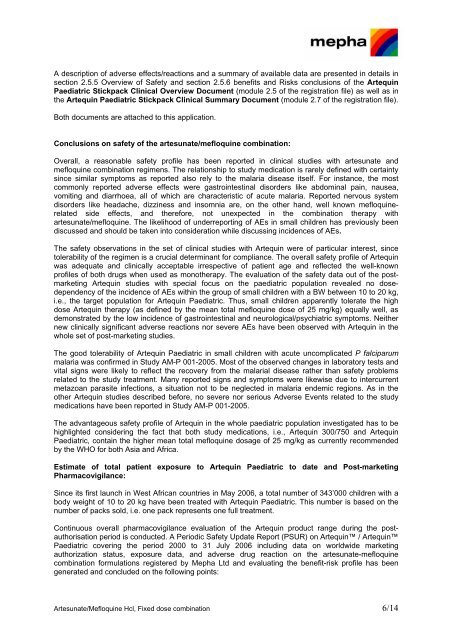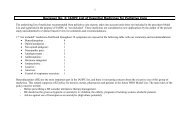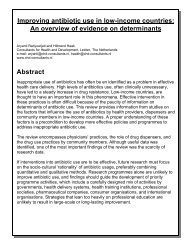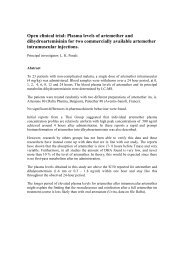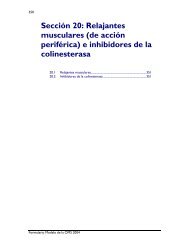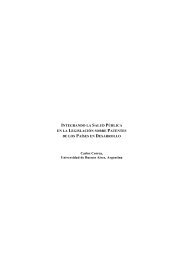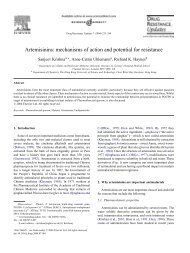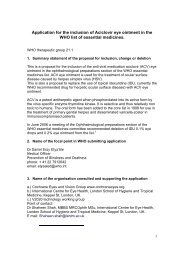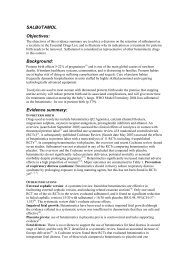Artesunate + mefloquine fixed-dose combination
Artesunate + mefloquine fixed-dose combination
Artesunate + mefloquine fixed-dose combination
Create successful ePaper yourself
Turn your PDF publications into a flip-book with our unique Google optimized e-Paper software.
A description of adverse effects/reactions and a summary of available data are presented in details in<br />
section 2.5.5 Overview of Safety and section 2.5.6 benefits and Risks conclusions of the Artequin<br />
Paediatric Stickpack Clinical Overview Document (module 2.5 of the registration file) as well as in<br />
the Artequin Paediatric Stickpack Clinical Summary Document (module 2.7 of the registration file).<br />
Both documents are attached to this application.<br />
Conclusions on safety of the artesunate/<strong>mefloquine</strong> <strong>combination</strong>:<br />
Overall, a reasonable safety profile has been reported in clinical studies with artesunate and<br />
<strong>mefloquine</strong> <strong>combination</strong> regimens. The relationship to study medication is rarely defined with certainty<br />
since similar symptoms as reported also rely to the malaria disease itself. For instance, the most<br />
commonly reported adverse effects were gastrointestinal disorders like abdominal pain, nausea,<br />
vomiting and diarrhoea, all of which are characteristic of acute malaria. Reported nervous system<br />
disorders like headache, dizziness and insomnia are, on the other hand, well known <strong>mefloquine</strong>related<br />
side effects, and therefore, not unexpected in the <strong>combination</strong> therapy with<br />
artesunate/<strong>mefloquine</strong>. The likelihood of underreporting of AEs in small children has previously been<br />
discussed and should be taken into consideration while discussing incidences of AEs.<br />
The safety observations in the set of clinical studies with Artequin were of particular interest, since<br />
tolerability of the regimen is a crucial determinant for compliance. The overall safety profile of Artequin<br />
was adequate and clinically acceptable irrespective of patient age and reflected the well-known<br />
profiles of both drugs when used as monotherapy. The evaluation of the safety data out of the postmarketing<br />
Artequin studies with special focus on the paediatric population revealed no <strong>dose</strong>dependency<br />
of the incidence of AEs within the group of small children with a BW between 10 to 20 kg,<br />
i.e., the target population for Artequin Paediatric. Thus, small children apparently tolerate the high<br />
<strong>dose</strong> Artequin therapy (as defined by the mean total <strong>mefloquine</strong> <strong>dose</strong> of 25 mg/kg) equally well, as<br />
demonstrated by the low incidence of gastrointestinal and neurological/psychiatric symptoms. Neither<br />
new clinically significant adverse reactions nor severe AEs have been observed with Artequin in the<br />
whole set of post-marketing studies.<br />
The good tolerability of Artequin Paediatric in small children with acute uncomplicated P falciparum<br />
malaria was confirmed in Study AM-P 001-2005. Most of the observed changes in laboratory tests and<br />
vital signs were likely to reflect the recovery from the malarial disease rather than safety problems<br />
related to the study treatment. Many reported signs and symptoms were likewise due to intercurrent<br />
metazoan parasite infections, a situation not to be neglected in malaria endemic regions. As in the<br />
other Artequin studies described before, no severe nor serious Adverse Events related to the study<br />
medications have been reported in Study AM-P 001-2005.<br />
The advantageous safety profile of Artequin in the whole paediatric population investigated has to be<br />
highlighted considering the fact that both study medications, i.e., Artequin 300/750 and Artequin<br />
Paediatric, contain the higher mean total <strong>mefloquine</strong> dosage of 25 mg/kg as currently recommended<br />
by the WHO for both Asia and Africa.<br />
Estimate of total patient exposure to Artequin Paediatric to date and Post-marketing<br />
Pharmacovigilance:<br />
Since its first launch in West African countries in May 2006, a total number of 343’000 children with a<br />
body weight of 10 to 20 kg have been treated with Artequin Paediatric. This number is based on the<br />
number of packs sold, i.e. one pack represents one full treatment.<br />
Continuous overall pharmacovigilance evaluation of the Artequin product range during the postauthorisation<br />
period is conducted. A Periodic Safety Update Report (PSUR) on Artequin / Artequin<br />
Paediatric covering the period 2000 to 31 July 2006 including data on worldwide marketing<br />
authorization status, exposure data, and adverse drug reaction on the artesunate-<strong>mefloquine</strong><br />
<strong>combination</strong> formulations registered by Mepha Ltd and evaluating the benefit-risk profile has been<br />
generated and concluded on the following points:<br />
<strong>Artesunate</strong>/Mefloquine Hcl, Fixed <strong>dose</strong> <strong>combination</strong> 6/14


